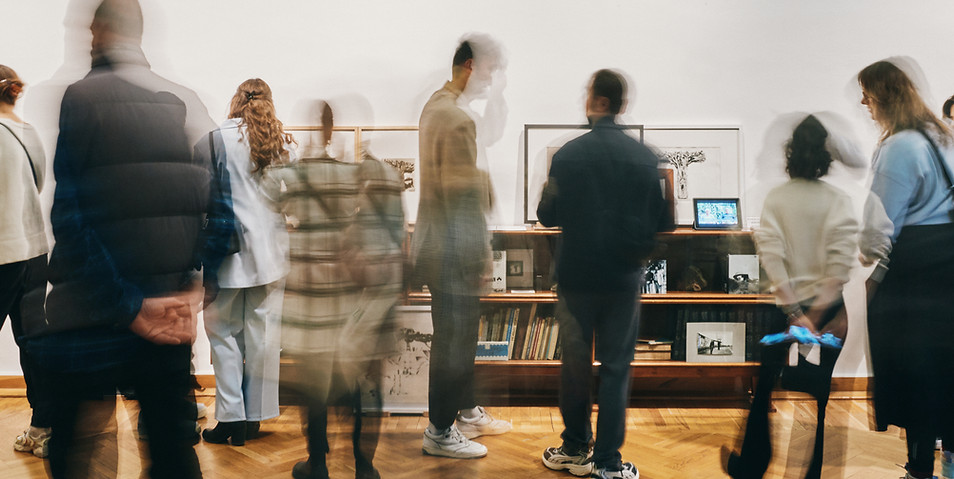EU4DIALOGUE PROJECT PRESENTATIONS
Exhibition / Goethe-Institute Georgien / Tbilisi (28. 03. – 12.05.2025)

EN
During the Soviet era, the notion of friendship between the "brother republics" was not only seen as an interpersonal relationship but also as an ideological foundation. Marxist theory framed comradeship and brotherhood as core values, which were shaped and regulated by the Soviet propaganda system. As a result, the concept of friendship took on a specific form and meaning that extended beyond individual relationships.
This project examines the Monument of Friendship of the Youth of the Transcaucasian Republics, erected in 1981 on the Red Bridge on the Georgian-Azerbaijani border. The exhibition scenography aims to connect remembering and forgetting, emphasizing the role and value of private archives – a time confined to paper. The archive is expanded through a video interview with the sculptor and architect, a VR version of the monument, AI-generated photographs, and a 3D model. The project was realized by an interdisciplinary group from Armenia, Georgia, and Azerbaijan.
By illuminating the past, an indirect link is created to critically question the discourses and practices of peace building in the South Caucasus over the past decades: Has there ever been a true emancipation from Soviet practices of encounter and exchange, and what does the notion of friendship mean in this context today? What significance does the existence of a place created specifically for this exchange have?
DE
Während der Sowjetzeit wurde die Idee der Freundschaft zwischen den „Bruderrepubliken“ nicht nur als zwischenmenschliche Beziehung betrachtet, sondern auch als ideologische Grundlage. Die marxistische Theorie verstand Kameradschaft und Brüderlichkeit als zentrale Werte, die durch das sowjetische Propagandasystem geformt und reguliert wurden. Dadurch erhielt das Konzept der Freundschaft eine spezifische Form und Bedeutung, die über individuelle Beziehungen hinausging.
Dieses Projekt untersucht das Monument der Freundschaft der Jugend der Transkaukasischen Republiken, das 1981 an der Roten Brücke an der georgisch-aserbaidschanischen Grenze errichtet wurde. Die Ausstellungs-Szenografie intendiert eine Verbindung von Erinnern und Vergessen und betont die Rolle und den Wert von Privatarchiven – einer Zeit, die an Papier haftet. Das Archiv wird durch ein Videointerview mit dem Bildhauer und Architekten, eine VR-Version des Denkmals, KI-generierte Fotos und ein 3D-Modell erweitert. Das Projekt wurde von einer interdisziplinären Gruppe aus Armenien, Georgien und Aserbaidschan realisiert.
Mit der Beleuchtung der Vergangenheit wird ein indirekter Bogen geschaffen zu einer kritischen Hinterfragung der Diskurse und Praktiken der Friedensarbeit im Südkaukasus der letzten Jahrzehnte: Gab es je eine wirkliche Emanzipation von sowjetischen Praktiken des Zusammentreffens und des Austausches, und was bedeutet der Begriff der Freundschaft in diesem Zusammenhang heute? Welche Bedeutung hat die Existenz eines Ortes, der speziell für diesen Austausch geschaffen wurde?
This exhibition was produced with the financial Support of the European Union and the Goethe-Institut under the EU4Dialogue project.
CURATOR: Irina Kurtishvili
FRIENDSHIP MONUMENT AT THE RED BRIDGE

Current state of the monument / Photography by Tako Robakidze, 2024

FRIENDSHIP MONUMENT / AI-generated image, 2025
EXHIBITION VIEWS:

Installation featuring vintage furniture from the estate of architect V. Kurtishvili, along with exhibits from the private archives of the architect and sculptor Gia Japaridze /
Photography by Giorgi Kolbaia

Table and chairs (1970s) from the estate of architect V. Kurtishvili, presented alongside the 3D model of the monument / Photography by Giorgi Kolbaia

Metal display tables presenting exhibits from the private archives, including SMENA magazine (1982), a presentation board, automobile road maps, miniature car models, and a framed color photograph by Tako Robakidze (2024) / Photography by Giorgi Kolbaia


Left: FRIENDSHIP MONUMENT AT THE RED BRIDGE. Arrangement with two black-and-withe photographs from the 1980s
Right: FRIENDSHIP MONUMENT. 3D model, thermoplastic material, 32 x 32 x 15 cm, 2025 / Photographs by Giorgi Kolbaia


Left: FRIENDSHIP MONUMENT. AI visualization created by an anonymous Azerbaijani artist, 2025
Right: Arrangement featuring an AI-generated image and the book by Vakhtang Beridze (1976) / Photography by Giorgi Kolbaia

Architect Vladimer Tsintsadze with his wife / Photography by Giorgi Kolbaia

MONUMENT AUTHORS, l. to r.: Sculptors Gogi Jgenti, Gia Japaridze, architect Vladimer Tsintsadze / Photography by Giorgi Kolbaia



AXALGAZRDA KOMUNISTI (Young Communist) No. 72. Daily newspaper in the Georgian SSR / Articles: "Long Live Fraternity, Love and Friendship" and "Glory to Brotherhood", June 16, 1981 / Archives of the National Parliamentary Library of Georgia / Photography by Sandro Sulaberidze
EXHIBITION
PROJECT MANAGER: Philomena Grassl, Goethe-Institut Georgien
CONTRIBUTING SCULPTORS: Gia Japaridze, Gogi Zghenti (Tbilisi)
ARCHITECTS: Valery Bakhtadze, Leo Bokeria, Vladimer Kurtishvili, Vladimer Tsintsadze (Tbilissi)
CONTRIBUTING ARTISTS AND LENDERS: interdisciplinary group from Armenia, Georgia, and Azerbaijan (anonymous artists)
PHOTOGRAPHER: Tako Robakidze (Tbilisi)
EXPOSITION: Scenography Irina Kurtishvili
EXHIBITION PRODUCTION: AA Architecture Ambience
GRAPHIC DESIGN: Mariam Natriashvili (Tbilisi)
ACKNOWLEDGEMENTS:
Irina Kurtishvili thanks the artists, sculptors, architects, and writers who contributed to the realization of this project.
Exhibition venue:
16 Mikheil Zandukeli St.
Tbilisi Georgia
+995 32 293 89 45